Input interpretation

pyridine
Chemical names and formulas

formula | C_5H_5N name | pyridine alternate names | azabenzene | azine | piridina | pyridin | pyridine-ring mass fractions | C (carbon) 75.9% | H (hydrogen) 6.37% | N (nitrogen) 17.7%
Lewis structure
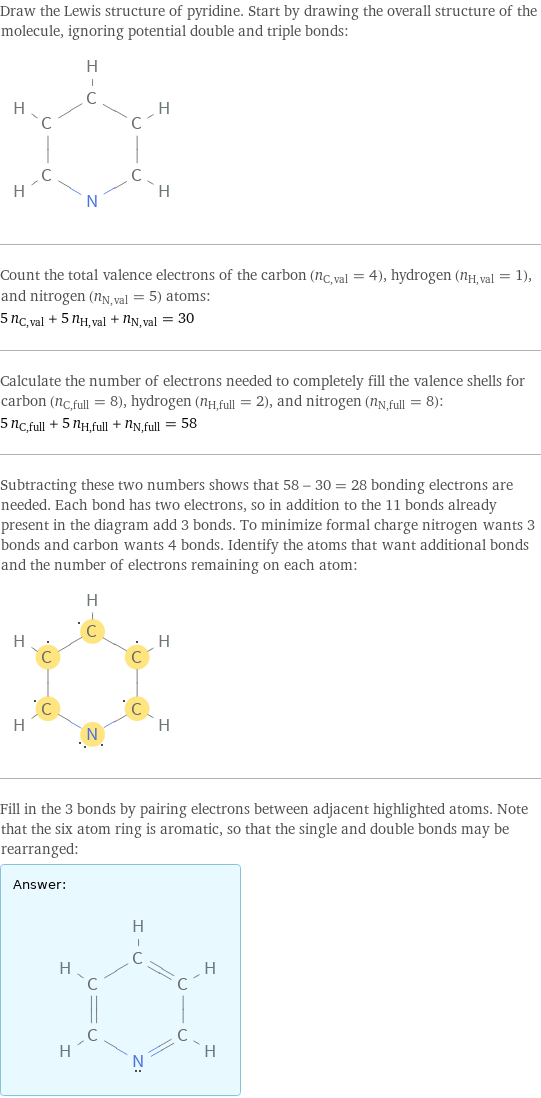
Draw the Lewis structure of pyridine. Start by drawing the overall structure of the molecule, ignoring potential double and triple bonds: Count the total valence electrons of the carbon (n_C, val = 4), hydrogen (n_H, val = 1), and nitrogen (n_N, val = 5) atoms: 5 n_C, val + 5 n_H, val + n_N, val = 30 Calculate the number of electrons needed to completely fill the valence shells for carbon (n_C, full = 8), hydrogen (n_H, full = 2), and nitrogen (n_N, full = 8): 5 n_C, full + 5 n_H, full + n_N, full = 58 Subtracting these two numbers shows that 58 - 30 = 28 bonding electrons are needed. Each bond has two electrons, so in addition to the 11 bonds already present in the diagram add 3 bonds. To minimize formal charge nitrogen wants 3 bonds and carbon wants 4 bonds. Identify the atoms that want additional bonds and the number of electrons remaining on each atom: Fill in the 3 bonds by pairing electrons between adjacent highlighted atoms. Note that the six atom ring is aromatic, so that the single and double bonds may be rearranged: Answer: | |
3D structure

3D structure
Basic properties
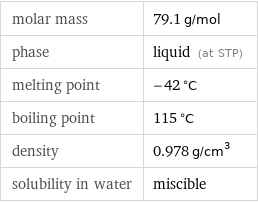
molar mass | 79.1 g/mol phase | liquid (at STP) melting point | -42 °C boiling point | 115 °C density | 0.978 g/cm^3 solubility in water | miscible
Units

Liquid properties (at STP)
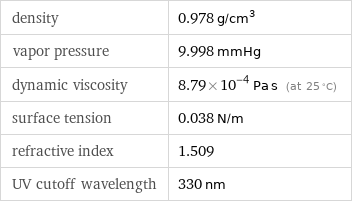
density | 0.978 g/cm^3 vapor pressure | 9.998 mmHg dynamic viscosity | 8.79×10^-4 Pa s (at 25 °C) surface tension | 0.038 N/m refractive index | 1.509 UV cutoff wavelength | 330 nm
Units
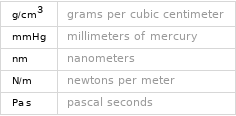
Thermodynamic properties
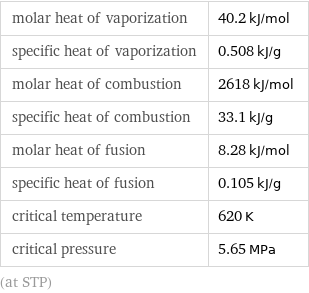
molar heat of vaporization | 40.2 kJ/mol specific heat of vaporization | 0.508 kJ/g molar heat of combustion | 2618 kJ/mol specific heat of combustion | 33.1 kJ/g molar heat of fusion | 8.28 kJ/mol specific heat of fusion | 0.105 kJ/g critical temperature | 620 K critical pressure | 5.65 MPa (at STP)
Chemical identifiers
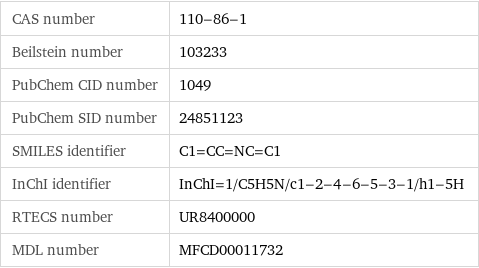
CAS number | 110-86-1 Beilstein number | 103233 PubChem CID number | 1049 PubChem SID number | 24851123 SMILES identifier | C1=CC=NC=C1 InChI identifier | InChI=1/C5H5N/c1-2-4-6-5-3-1/h1-5H RTECS number | UR8400000 MDL number | MFCD00011732
NFPA label

NFPA label

NFPA health rating | 3 NFPA fire rating | 3 NFPA reactivity rating | 0
Safety properties
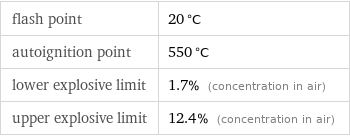
flash point | 20 °C autoignition point | 550 °C lower explosive limit | 1.7% (concentration in air) upper explosive limit | 12.4% (concentration in air)

DOT hazard class | 3 DOT numbers | 1282
Toxicity properties

lethal dosage | 891 mg/kg (oral dose for rats) short-term exposure limit | 30 mg/m^3 threshold limit value | 1 ppmv

probable lethal dose for man | 600 mL (milliliters) long-term exposure limit | 15 mg/m^3 (over 8 hours) RTECS classes | tumorigen | mutagen | primary irritant